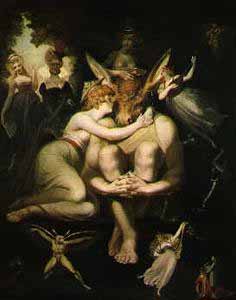Science unlocks secrets of the elixir of love
By Chris AyresWhat makes romance sizzle is one of life's mysteries.
One day the answer could come in a bottle
SHAKESPEARE imagined it to be a potion made from flowers; Joyce pictured a seed cake, eaten straight from a lover’s mouth. And the romantic poets were convinced it was everything from the charge from an electrical battery to a lungful of opium.
The search for the true elixir of love, however, may finally have come to an end. Helen Fisher, a prominent anthropologist at Rutgers University in New York, claims to have identified the likely ingredients of the chemical cocktail that causes human beings to fall in love.
Not only that, but Ms Fisher also believes that the love elixir produced naturally by the body — for Darwinian reasons, she claims — could one day be replicated in a laboratory. Eventually, her argument goes, jaded couples could be prescribed a drug to make them fall in love all over again.Ms Fisher’s research, in a new book, Why We Love: The Nature and Chemistry of Romantic Love, took eight years to complete and involved brain scanning technology known as fMRI, or functional magnetic resonance imaging.
Ms Fisher, 58, says that she has been in love many times herself, with four “really important sweethearts”. But the subjects for her study were 800 students who answered a flyer on a bulletin board at the State University of New York at Stony Brook. It read: “Have you just fallen madly in love?”
The exact quantities of the chemicals that make up the human body’s love elixir remain a mystery. But Ms Fisher says she is convinced of the two main ingredients: dopamine and norepinephrine. She also found decreased levels of serotonin in her loved-up subjects, meaning any love pill would probably have to include a chemical agent to help reduce levels of serotonin in the brain.
Worryingly, Ms Fisher’s research suggests that anti- depressants, which boost serotonin levels, could make it harder to fall in love. “The chemistry of romantic love may be reproduced someday,” says Ms Fisher. “Curiously, the problem is who you would fall in love with.” This, she says, could land patients in the same situation as Titania in Shakespeare’s A Midsummer Night’s Dream, who ended up falling for Bottom, in spite of his donkey’s head.
“It reminds me of a story about a man who was in love with a young woman in China,” she says. “He knew that if they did something exciting together she would be more likely to fall for him. So he took her out for dinner. And he had a rickshaw take them there. But when they got out of the rickshaw, the woman turned to the man and said, ‘Wasn’t that rickshaw driver a handsome man’?”
Ms Fisher says her research has not ruined the mystery of human longing. “You can know every single ingredient of chocolate cake and still sit down and eat it and feel intense joy. This has simply broadened my awe of nature.”
Those who make a living trying to explain what has so far been unexplainable are surprisingly enthusiastic. “I love the idea,” says Molly Peacock, president emeritus of the Poetry Society of America. “I love it when there’s biological proof for human instincts and impulses that have been written about forever. In a way, it’s physical evidence for poetry.”
Ms Fisher organised her research by putting her subjects into the cylindrical tube of the fMRI machine and showing them pictures of their loved one, reflected in a mirror. They were then shown pictures of a “neutral” person (chosen by the subject) and told to do a mathematical exercise to “clean” their brains. All the while, the fMRI machine clicked and whirred, taking 144 samples of brain activity over a 12-minute period. The machine then showed exactly which parts of the brain were sucking up blood and were therefore being used when the subject was thinking of the loved-one (blood provides the glucose and oxygen needed by the brain’s regions to operate).
And Ms Fisher knew from research into the brains of voles, weasels and other animals which chemicals were common in each part of the brain. “I knew that dopamine, norepinephrine and serotonin were much more prevalent in some brain regions than in others,” she wrote. “If I could establish which regions became active while one is feeling romantic rapture, that might confirm which primary chemicals were involved.” The effects of dopamine and norepinephrine will come as a surprise to no one beyond puberty: elation, intense energy, sleeplessness, craving, loss of appetite and focused attention. But Ms Fisher argues that the human body releases the cocktail of love rapture only when certain conditions are met and that men more readily produce it than women, because of their more visual nature. Who you fall for depends on timing, proximity — “You tend to fall in love with people you are near” — and mystery, because you have to be intrigued by someone. “They’re also usually from a similar background, ethnic group and have a similar level of education. Most importantly, they fall within your ‘love map’. When you grow up, you build an unconscious list of things you are looking for in a mate.”
As for the Darwinian explanation for love, Ms Fisher says that men are more likely to go for looks because they are programmed to look for healthy females to bear children. Women tend to remember details of a relationship because they need to know whether the male will be a good provider. Using Darwinian logic, both sexes experience the contentment of love so they can stay together and raise children.
Would the romantic poets have approved of all this science and logic? Fred Burwick, Professor of English Literature at the University of California, Los Angeles, says they would have been intrigued. “Human beings have a long tradition of looking for the solution to our problems in bottles,” he says.
LOVE POTIONS OVER THE AGES
- Ulysses: In James Joyce’s erotic classic Ulysses, it is a seed cake that becomes the elixir of love. The character Molly Bloom allows her lover to eat seed cake out of her mouth while they are lying amid the rhododendrons on Howth Head. He proposes. Joyce’s seed cake was later referred to in the 1989 album The Sensual World by Kate Bush
- L’elisir d’amore (The elixir of love): In Gaetano Donizetti’s comic opera, first performed in 1832, the character Nemorino believes he has bought a love potion but instead it turns out to be a cheap bottle of Bordeaux. The real elixir of love, the Italian composer goes on to argue, is money
- A Midsummer Night’s Dream: The plot of William Shakespeare’s work revolves around a flower-based potion that makes Titania, Queen of the Fairies, fall in love with Bottom, a man with a donkey’s head. The Royal Society of Chemistry and the Royal Shakespeare Company later tried to reproduce the scent with a perfume called Puck’s Potion, named after Titania’s sidekick
- Confessions of an English Opium-Eater: Thomas De Quincey believed that he had found the essence of love and happiness when he first tried opium
- Love Potion No. 9: In the 1959 song, performed by the Clovers, the songwriting duo Jerry Leiber and Mike Stoller claim the elixir of love came in bottles for sale on the streets of an American city

